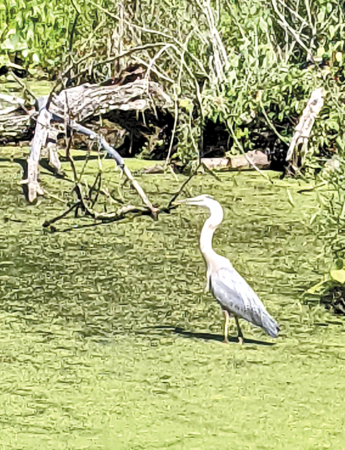When I mentioned wading birds in the title, I am actually referring to a family of birds known as the Heron Family. Pennsylvania is host to over a half-dozen different species of herons, but the two you are most likely to spot are the Great Blue Heron and the Great Egret often referred to as a common egret. If you are really looking closely and you know what to look for, you may spot a Green Heron on a branch next to the water in a secluded swamp. If you are really observant you may get lucky and spot an American Bittern staring straight up at the sky and blending perfectly with the surrounding vegetation. The American Bittern is a fairly rare sighting, and I have only seen one in the last ten years standing amidst cattails on the edge of a lake.
One of the reasons herons are so hard to see is they are very stealthy birds that often stand motionless for long periods of time and even when they do move, they are very deliberate. Another factor that makes them hard to spot is they often blend in with their vegetative background very well. One of the exceptions to the “blending in” scenario is the common egret — they are white and stand out exceptionally well. The Great Blue Heron on the other hand, is a dull blue/gray and can often be hard to spot even as it very cautiously makes its way along a swampy shoreline.
I have been spotting Great Blues all summer long — oftentimes in flight overhead. Because they are large like eagles, people sometimes take a quick look and think they are seeing a passing eagle; look for the long legs sticking out behind the wings as they fly by — it’s a dead giveaway.
Swamps, ponds, streams, and even the shoreline of the Susquehanna are common places to spot Great Blues. I recently watched one snap up a large bluegill and yes, they swallow their prey whole. Herons are predators feeding on fish, frogs, crayfish, insects, invertebrates, small rodents, and even snakes; they swallow their food whole and later regurgitate pellets of indigestible matter.
Over the past few weeks, I have been seeing a fair number of the Great Egrets; of course, the bright white feathers make them easy to spot wading the edge of the river. (Don’t mistake the white plastic bag hanging from a branch along the creek for an egret — like the egret they too are becoming more common). While heading to the Harrisburg area last week I spotted three or four at different locations along the Susquehanna River.
At one time the common egret was nearly wiped out; the birds were killed for their long white body plumes that were used to feather women’s hats. Today all herons are now protected, and the Great Egret is increasing in numbers even here in Pennsylvania.
While reading up on herons, I came across another interesting little tidbit. Herons have what is known as “powder down” or areas of feathers where the tips continually disintegrate into powder. Preening helps to distribute this powder which absorbs and removes fish oil, scum, and slime thus keeping the rest of the plumage clean and dry.





Leave a Comment
Your email address will not be published. Required fields are marked with *